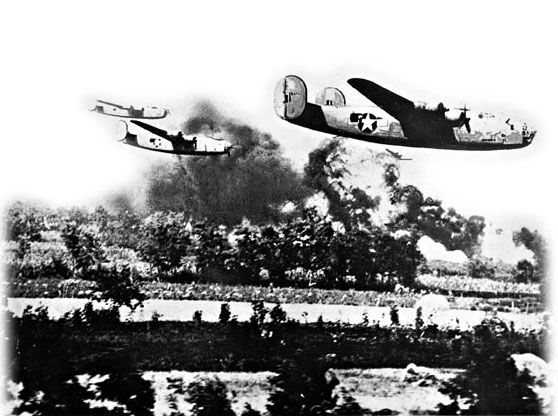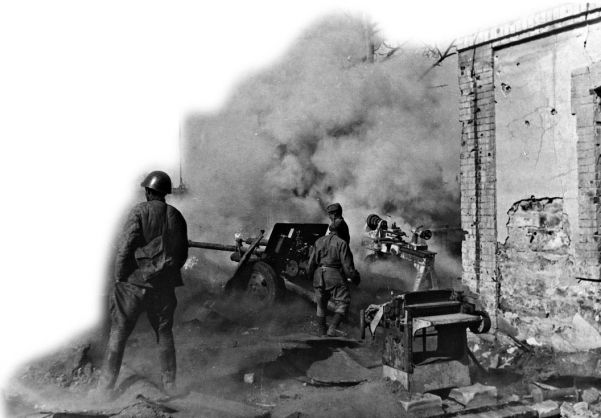1 August
Air War, Romania

A US force of 178 bombers make a 1000-mile (1500-km) flight from Libya to attack the Ploesti oil fields, which provide essential supplies to Axis forces. The low-level attack is met by fierce antiaircraft fire and 54 aircraft are lost. Damage to the oil fields is superficial but increases Hitler’s fears over the area’s susceptibility to air raids or ground attack.
2 August
Eastern Front, Ukraine
Adolf Hitler orders Field Marshal Erich von Manstein to hold the line firmly around Kharkov. Hitler is keen to prevent the Eastern Front being pushed farther westward by the likely Soviet summer offensive. However, German forces in the region lack the manpower, tanks, and artillery to halt the Red Army permanently.
3 August
Politics, Italy
The Italian regime puts out peace-feelers to the Allies. In reply, the Allies lay down the following conditions for an armistice: the handing over of the fleet; all Italian territories to be made available to the Allies for military operations; Allied prisoners in Italy to be freed and not be allowed to fall into German hands; and the disarming of all ground and air forces.
3-16 August
Mediterranean, Sicily
Italian forces withdraw from Sicily. Catania surrenders to the British on the 5th.
4-11 August
Eastern Front, Ukraine
Red Army units retake Orel and Belgorod by the 5th. The Voronezh and Steppe Fronts are near Kharkov.
5-22 August
Pacific, Solomons
US forces capture the important Munda airfield on New Georgia Island. Japanese resistance on the island disintegrates and the defenders are not to be reinforced. A sea evacuation is made from the north of the island to neighboring Kolombangara on the 22nd.
6 August
Mediterranean, Italy
German reinforcements begin arriving in Italy. Hitler orders four operations: the rescue of Mussolini from imprisonment by the new Italian government, the formation of a strong Italian defense line, the revival of fascism, and the seizure of the Italian fleet. Hitler also wishes to occupy as much of Italy as possible, using it as a bastion to keep the war as far away from Germany as possible.
6-7 August
Sea War, Pacific
Four Japanese destroyers carrying troops and supplies to Kolombangara in New Georgia fight a night action against six US destroyers at the Battle of Vela Gulf. Torpedo strikes sink three Japanese destroyers and claim 1210 lives. No US vessels are damaged.
8-17 August
Mediterranean, Sicily
US forces advancing along the coast are assisted by amphibious landings east of San Stefano. British, Canadian, and Free French Moroccan troops have fought a series of bitter actions to overcome determined German resistance to the southwest of Mount Etna. The Germans finally start withdrawing on the 11th and evacuate 100,000 Axis troops before US forces enter Messina on the 17th. Around 10,000 Germans have been killed or captured during the campaign. The Italians have lost 132,000 men, mainly prisoners. The British and US forces have suffered 7000 fatalities and 15,000 men have been wounded. The capture of Sicily means the Allies have a springboard for the invasion of Italy.
13-24 August
Politics, Allies
British Prime Minister Winston Churchill and US President Franklin D. Roosevelt attend the First Quebec Conference in Canada. Britain reaffirms US control over the Pacific theater, where it is intensifying operations. Further Chindit operations are proposed for Burma and aid to Chiang-Kai-shek in China will continue. Vice Admiral Lord Louis Mountbatten takes charge of Southeast Asia Command. Fighting in Italy will intensify to capitalize on Mussolini’s downfall. They adopt British General Sir Frederick Morgan’s plan for the cross-Channel invasion, Operation Overlord, scheduled for May 1, 1944. Floating artificial ports (Mulberry Harbors) are to be built in Britain and towed to the French beaches. The supreme commander for the invasion will be a US senior general.
15 August
Pacific, Aleutians
A US and Canadian amphibious assault on Kiska Island finds that the Japanese garrison has been evacuated.
17-18 August
Air War, Germany
The rocket research center at Peene-münde on the Baltic Sea is attacked by 597 British bombers. The center has been developing a remote-controlled, pulse-jet-powered ‘Flying Bomb’; (V1) and a faster, liquid-fuel model (V2) as terror weapons to undermine the morale of enemy populations. The raid kills 732 people and delays V2 testing. The British lose 40 aircraft. A raid by 230 US bombers is made on ball-bearing works at Schweinfurt and Regensburg. Around 20 percent of the bombers are destroyed.
19 August
Pacific, Papua New Guinea
Allied forces finally take the Japanese strongpoint of Mount Tambu. Japanese troops are now wedged between Salamaua and the Francisco River.
22-23 August
Eastern Front, Ukraine

Kharkov is retaken by the Red Army. The Soviets now seriously threaten the southern area of the German Front in Ukraine and are well placed for advancing to the Dniepr River. The Soviets have won victories at Kursk, Orel, and Kharkov by exhausting the enemy with fierce defensive actions followed by decisive counterattacks.
26 August
Eastern Front, Ukraine
Soviet forces begin their offensive to seize the Eastern Ukraine and cross the Dniepr River. The river forms a key part of the German defenses established to halt Red Army advances.
28 August
Politics, Denmark
The Danish government resigns after refusing a German demand for the repression of ‘saboteurs.’; The Danish authorities have tried to avoid collaboration with Germany. Martial law is declared on the 29th, the army is disarmed but many Danish warships are scuttled or sent to Sweden before the Germans can seize them.
